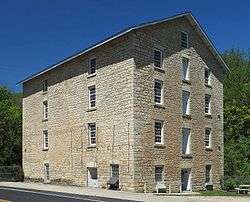Pickwick Mill
Pickwick Mill is a historic gristmill in the unincorporated community of Pickwick, Minnesota, United States, near the city of Winona. It was constructed in the mid-1850s and is now operated as a milling museum. Pickwick Mill was listed on the National Register of Historic Places in 1970 for having state-level significance in the themes of agriculture, architecture, and industry.[2] It was nominated for being one of southeast Minnesota's oldest surviving water-powered mills, serving as a key local industry in its day and a Winona County landmark to the present.[3]
Pickwick Mill | |
 Pickwick Mill from the southeast | |
  | |
| Location | 24813 County Road 7, Pickwick, Minnesota |
|---|---|
| Coordinates | 43°58′49.4″N 91°29′48.2″W |
| Area | 1 acre (0.40 ha) |
| Built | 1854 |
| NRHP reference No. | 70000314[1] |
| Added to NRHP | September 22, 1970 |
Description
The six-story building was constructed from local limestone with a nail-less timber frame and a pitched roof. In 1907 a tornado ripped up the roof and top story, which the operators replaced with a flat plank roof. A more classically accurate pitched roof was restored in recent years.[4] The mill is powered by a 20-foot (6 m) water wheel.[5] Most of the mill's original machinery is still intact and operable.[3]
History
Pickwick Mill was built on the banks of Big Trout Creek by Thomas Grant and Wilson Davis. The mill's official website says it was constructed 1856–58,[4] though other sources give a construction date of 1854.[2][6] The property's National Register nomination says it was built in 1854 as a grist- and lumber mill and converted to flour production in 1856.[3]
Pickwick Mill is one of the largest mills in Minnesota and was one of the first community businesses in the state.[6] During the American Civil War the mill ran non-stop, churning out 100 barrels of flour a day for the Union Army.[4]
Historic attraction
Pickwick Mill is now managed by Pickwick Mill Inc., a non-profit organization largely funded by grants.[4][6] It is open for tours from May to October.[5]
See also
References
- "National Register Information System". National Register of Historic Places. National Park Service. July 9, 2010.
- "Pickwick Mill". Minnesota National Register Properties Database. Minnesota Historical Society. 2009. Retrieved 2015-06-23.
- Grossman, John (1970-05-11). "National Register of Historic Places Inventory – Nomination Form: Pickwick Mill". National Park Service. Retrieved 2015-07-05. Cite journal requires
|journal=(help) - "Pickwick Mill". Pickwick Mill Association. 2015. Retrieved 2015-07-06.
- "The Historic Pickwick Mill". Explore Minnesota. Retrieved 2015-07-06.
- Pederson, Alyssa (2010-07-16). "Pickwick Mill going strong". Winona Daily News. Winona, Minn. Retrieved 2015-07-06.

